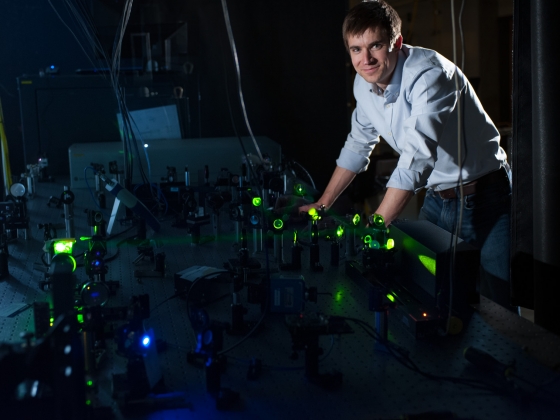BOZEMAN, MT – May 22, 2015 – (RealEstateRama) — A Montana State University faculty member who investigates new materials for solar cells has received an early career award from the U.S. Department of Energy.
“It was a real surprise. It’s one of those things you don’t really expect to happen in your first year,” Erik Grumstrup said of the five-year, $750,000 grant.
Grumstrup came to MSU last summer to join the new Materials Science Graduate Program, a Montana University System collaboration involving MSU, Montana Tech and the University of Montana. The first person hired for the program, he is also an assistant professor in MSU’s Department of Chemistry and Biochemistryin the College of Letters and Science.
“These are very, very competitive awards,” said Rob Walker, chemistry professor and director of the Materials Science Graduate Program. “From a program, department, college and university standpoint, Erik’s award is an accomplishment that we can all look to with pride.”
He added that, “Erik is also a great colleague. He is smart. He cares about all the right things. He is a very good fit for Montana State. He has the right balance between his research focus, innovation and mentoring. He is already an outstanding adviser for the graduate students who have joined his research program.”
Grumstrup said the grant will allow him and his students to study “disordered semiconductors,” with the goal of understanding materials that may reduce the cost of solar cells and make them more efficient. Explaining disordered semiconductors, he said electrons move through current solar cell materials like cars on an interstate – with well-defined speeds and few interruptions. However, electrons moving through disordered semiconductors are like cars traveling through neighborhoods. Speeds vary, and “stop signs” cause frequent interruptions.
“We are really interested in the nature of those stop signs,” Grumstrup said. “What slows down electrons? How does the added complexity of all the different structures change the underlying physics?
Working with Grumstrup on the project titled, “Photoconversion in Disordered Semiconductors: Spatial, Spectral and Temporal Insights through Nonlinear Microscopy” will be three graduate students and two undergraduates. Andy Hill, a doctoral student in materials science, and Eric Massaro, a doctoral student in chemistry, already work in Grumstrup’s laboratory.
“It’s nice to have a group established already and that seem excited about what we are doing,” Grumstrup said. “Hopefully, we can move pretty quickly and make some progress right away.”
With the new grant awarded in his first year at MSU, the word “ultrafast” regularly appearing up in the papers he has published, and his South Dakota reputation as a standout runner, speed seems to be a theme in Grumstrup’s life. By the time he graduated from Stevens High School in Rapid City, he had been South Dakota’s high school cross country runner of the year three times. Fourteen years after graduating from high school, he still holds the state record in the two-mile.
Now – saying chemistry is more important to him than running — Grumstrup said he appreciates the support he has felt from his MSU colleagues, and he is happy about the opportunities the new grant will provide.
“The wonderful thing about getting a grant is that you can actually do the work that you are so excited about doing,” Grumstrup said.
Grumstrup was born in Bozeman and moved away when he was about five years old. Noting that his return is a dream come true, Grumstrup earned his bachelor’s degree in 2006 from the University of Minnesota Twin Cities. He earned his Ph.D. in 2011 at the University of Colorado Boulder.
###
MSU News Service
Tel: (406) 994-4571
msunews (at) montana (dot) edu



